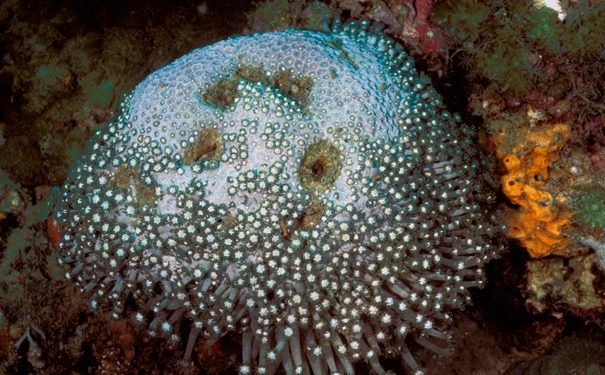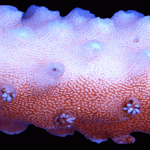
A partially bleached coral head may offer some shelter. Image (c) Wolcott Henry 2005/Marine Photobank
Some fish turn aggressive when they have to share limited resources.
Coral bleaching is already causing serious changes to reef environments around the world, with some badly bleached areas only containing a few live species among the dead coral. As these skeletons break down, the area becomes simpler in structure and fewer fish species can survive there. This can lead to deadly competition for shelter among the ones that are left.
The bushy and branching forms of coral are the most susceptible to damage, according to Professor Mark McCormick from James Cook University. This is bad news for many damselfish species, as they have strong associations with these types of coral. The lemon damselfish (Pomacentrus moluccensis), for example, will associate with live coral for its whole life.
Other more flexible species, such as the ambon damselfish (Pomacentrus amboinensis), can use other habitats but they may not thrive in these environments. “Living in less preferred habitats may affect how well they feed or avoid predators, influencing their growth, reproduction and survival,” McCormick says.
Changes to the preferred environment can have deadly consequences for some of these species. When he investigated the changes in behaviour and competition between lemon damselfish and ambon damselfish juveniles in a new study published in the Proceedings of the Royal Society B, he found that if the two species were found together on dead coral, the ambon damselfish became more aggressive. It would then try to drive the lemon damselfish away from the coral head, leaving the specialist more exposed to predators.
This led to a higher mortality rate among the lemon damselfish. “This higher mortality, however, only occurred when the two species were together, showing that it was the behavioural interactions between the two species that lead to the loss of the lemon damselfish specialist from the degrading habitat during this phase in its life,” McCormick explains.
He says that behavioural changes may also be observed in other fish as the reef degrades, which would affect their numbers. “It is the behaviour of the animals and how they interact together and with their environment that underlies the process that regulate numbers of fishes on our reefs,” he says. “We’ve found in other studies that the balance of cues used to avoid predators or detect prey change with the degradation of corals, and this will influence how fishes behave and interact.”






